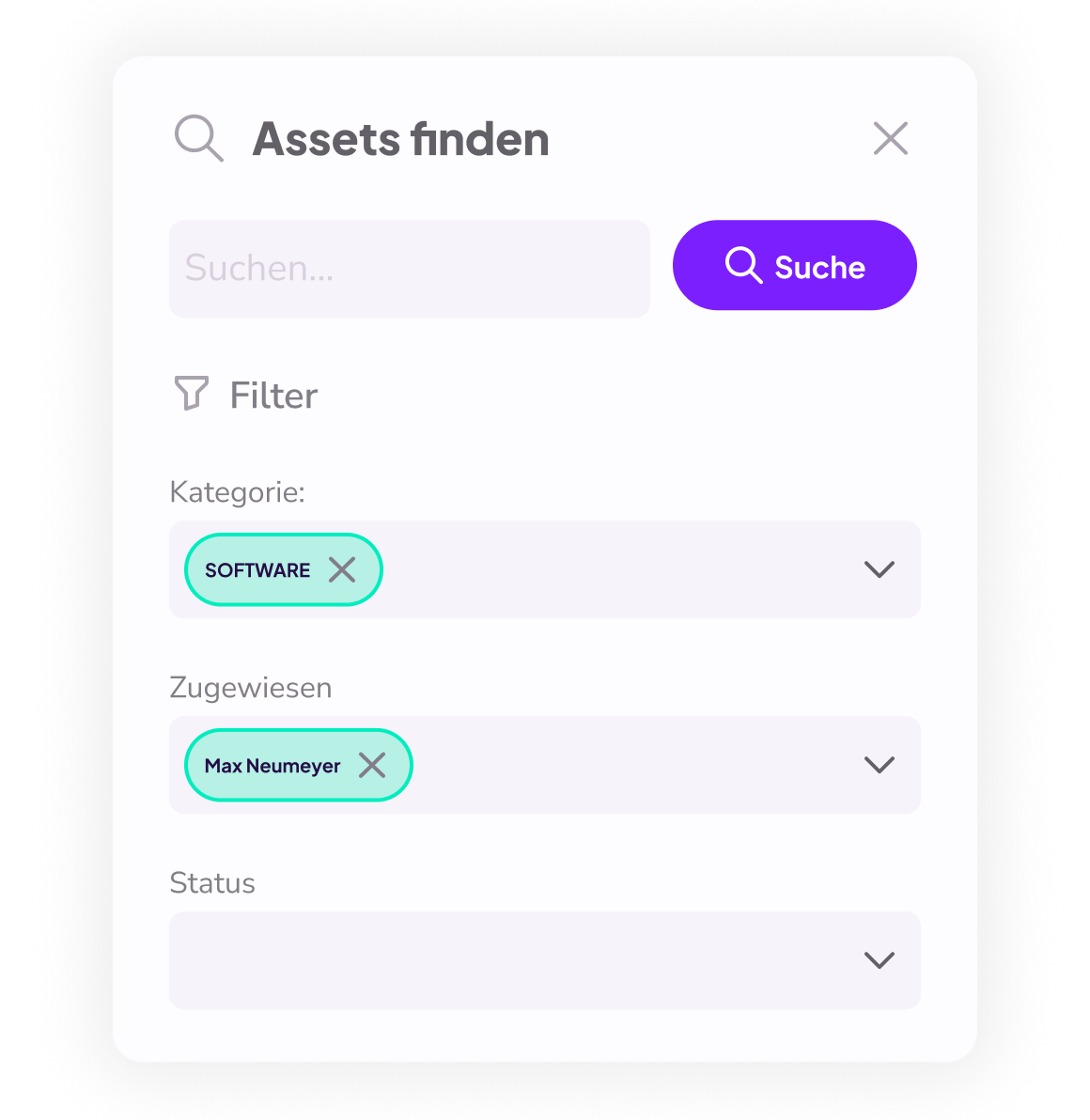Inventarisierung von Mitarbeitergeräten, IT-Hardware und Unternehmensassets effizient, kostensparend und nachhaltig
Für Unternehmen ist eine funktionierende Inventarisierung von Mitarbeitergeräten (Notebooks, Handy, etc.), IT-Hardware und anderen Unternehmensassets essentiell. Scheitern diese Prozesse, entstehen Mehrkosten, Störungen im operativen Ablauf und eine schlechte Experience für MitarbeiterInnen. Die Gründer von sortful kennen diese Themen aus ihrem bisherigen beruflichen Leben und haben sich entschlossen, eine Plattform zu bauen, um Inventarisierung für alle Beteiligten zu optimieren.
Herausforderungen der Inventarisierung

Wer kennt es nicht? Einmal jährlich müssen die meisten Unternehmen für den Jahresabschluss ihr Inventar erfassen. Für viele ist dies mit großem Aufwand, Zeit und Kosten verbunden – Inventar muss individuell von jedem Mitarbeiter erfragt und mit den Daten aus der Finanz-Software abgeglichen werden. Und danach? Business as usual und der gleiche Höllenritt wartet im Folgegeschäftsjahr wieder, sofern keine kontinuierliche Inventarisierung im laufenden Betrieb stattfindet.
Fehlender Überblick: Wer, wo, was, wann?
- Wer hat welche Geräte zugewiesen?
- An welchem Standort?
- Gibt es ungenutzte Geräte, die ggf. anderweitig eingesetzt werden können?
- Gibt es Inventar, welches nicht mehr benötigt wird?
- Geht vorrätiges Inventar bald aus?
Diese Fragen lassen sich in der Regel nicht ad hoc beantworten, wenn Inventarisierung nicht als Prozess gedacht wird – von der Anfrage bis zum Wiederverkauf / Entsorgung. Eine statische Pflege des Inventars über – Klassiker – Excel-Listen ist fehleranfällig, nicht skalierbar und erschwert dynamische Prozesse, wie Änderungen von Zuweisungen.
Holpriges On- und Offboarding

Aber es geht nicht nur um den aktuellen Bestand und kontinuierliche Inventarisisierung- auch zukünftiger Bedarf für z.B. neue MitarbeiterInnen wird in der Regel nur rudimentär über Ticketsysteme erfasst. Im schlechtesten Fall kommen Geräte beim Mitarbeiter zu spät an oder müssen nach- oder umbestellt werden. Umgekehrt kann der offboarding-Prozess mühselig werden, wenn unklar ist, welche Geräte dem Mitarbeiter zugewiesen sind. Worst case: Hardware und Geräte verschwinden. In jeden Fall steht viel auf dem Spiel – nämlich neben Produktivitätsgesichtspunkten eine gute employee experience, die wesentlich dafür ist, wie Mitarbeiter die Kultur und Organisation eines Unternehmens wahrnehmen.
Schlechte Kosten- und Umweltbilanz

Ungenutzte Geräte erzeugen versteckte Kosten und beeinträchtigen die Rentabilität eines Unternehmens. Falls langfristig kein Bedarf an diesen Geräten besteht, können sie wiederverkauft oder zum Beispiel sozialen Einrichtungen überlassen werden. Landen die Geräte auf dem Müll, trägt dies zu einer negativen Umwelt- aber auch Kostenbilanz mit bei: Zum einen investiert jedes vierte Unternehmen in Deutschland mehr als 100.000 € für die Entsorgung ihrer Geräte – ein Kostenpunkt, der deutlich reduziert werden kann. Zum anderen werden nach Angaben des Weltwirtschaftsforums jedes Jahr rund 50 Millionen Tonnen elektronischer Schrott produziert – Tendenz steigend. Die Lösung dieses Problems? Die Integration von Refurbishment oder IT-Remarketing in den bestehenden Inventarisierungsprozess für ein kostensparendes und umweltbewusstes wirtschaftliches Handeln.
Kosten sparen durch smarte Inventarisierung
Smarte Inventarisierungssoftware für die Verwaltung Ihrer Geräte, Maschinen, IT-Hardware, Büroinventar und anderer Vermögenswerte spart Kosten. Berechnen Sie jetzt mit dem Kalkulator wie viel Sie pro Jahr sparen können. Und erhalten Sie Tipps, wie Sie ihre Nachhaltigkeitsbilanz durch den Verkauf von alten und nicht mehr benötigten Assets optimieren können.
Wie kann mir sortful für meine Inventarisierung helfen?
Transparenz von Anfang an über integriertes Anfragenmanagement
Mit sortful beginnt Inventarisierung nicht erst bei der Erstaufnahme eines neu gekauften Assets, sondern bereits wenn der Bedarf entsteht:
- MitarbeiterInnen oder HR / IT / OfficeManager können Anfragen für neue Geräte, Büroinventar oder auch subscriptions stellen – diese Anfrage wird dann zum passenden Administrator geleitet.
- Hinterlegte workflows, Kommentarfunktionen und email notifications sorgen für einen transparenten Ablauf.
- Administratoren haben per dashboard Zugriff auf alle Anfragen und können diese nach verschiedenen Attributen (z.B. nach Standort, Mitarbeiter, Gerätetyp, Deadlines) filtern.


Asset Management & QR-Code-Etiketten für Geräte, Hardware und anderes Unternehmensinventar
Ist eine Anfrage abgeschlossen, können die Anfragedaten als Assetdaten übernommen werden – für das Asset wird eine eindeutige ID generiert und es wird automatisch ein QR-Code erzeugt, der als Etikett auf das Gerät angebracht wird und via mobile-phone ausgelesen werden kann. Onboarding- und Offboarding-Prozesse werden dadurch deutlich vereinfacht, Übergabepunkte an MitarbeiterInnen werden compliance-gerecht in sortful dokumentiert.
Administratoren können über vielfältige Such- und Filterfunktionen das Inventar prüfen:
- Es werden neue Bildschirme für Standort X benötigt? Am Standort Y gibt es ungenutzte.
- Eine neue Mitarbeiterin benötigt ein notebook? Erst einmal nach ungenutzten notebooks suchen, bevor ein Neukauf oder Leasing in Erwägung gezogen wird.
- Ein Lizenzvertrag wird automatisch zu einem bestimmten Stichtag verlängert? Als Administrator erhalten Sie eine notification und können entscheiden, ob eine Verlängerung Sinn macht oder ob das Abo gekündigt werden soll.


Refurbishing und Reselling für alte Hardware und Geräte
Ungenutzte oder nicht mehr benötigte Hardware (Server, notebooks, stationäre Rechner, Mobiltelefone) kann über My SAM an Reselling / IT-Remarketing-Partner verkauft werden. Die Hardware kann ohne Einbindung von Kundenresourcen vor Ort abgeholt / demontiert werden, auch eine Datenlöschung vor Ort ist möglich. Sicherheit steht dabei an erster Stelle: Revisionssichere Datenlöschung / Datenträgervernichtung werden BSI-konform und nach DSGVO durchgeführt, ein lückenloses Reporting garantiert einen nachvollziehbaren und lückenlosen Auditbericht.

Welche Vorteile hat mein Unternehmen durch digitale Inventarisierung?
Kosteneinsparung 💰
Laut einer Studie von Gartner können Unternehmen, die ein IT-basiertes Tool zur Inventarisierung einführen, ihre Assetkosten um 30% im ersten Jahr und um 5-10% in den Folgejahren reduzieren (Gartner Inc, CS-17-113: Using IT Asset Management to Ensure Software Compliance, Patricia Adams, July 29, 2002). Organisationen mit einem funktionierenden IT Asset Management haben 15% weniger TCO (totalcost of ownership). Die größten Einsparungen gibt es im Einkauf (160%), in der Entsorgung (60%) und Operations (44%).
Nachhaltigkeit durch Refurbishing
von IT-Hardware und Altgeräten 🌳
Refurbishing ist die Wiederherstellung von gebrauchten Produkten in einen technisch und optisch einwandfreien Zustand, und es ist eine sinnvolle Praxis, weil es sowohl wirtschaftlich als auch ökologisch Vorteile bietet. Die Herstellung eines Notebooks (SSD) verursacht durchschnittlich 311 kg CO2e -zum Vergleich: Ein Mittelklasse-Benziner stößt ca. 25kg CO2 pro 100 km (Stadtverkehr) aus. Wird alte und nicht benutzte IT Hardware durch Refurbishing / IT-Remarketing wieder dem Wirtschaftskreislauf zugeführt, lassen sich messbar CO2-Emissionen einsparen (https://www.oeko.de/fileadmin/oekodoc/Digitaler-CO2-Fussabdruck.pdf), der Abfall von Elektronikschrott wird reduziert und die Lebensdauer von Geräten und Hardware verlängert.
Höhere Zufriedenheit und Produktivität von MitarbeiterInnen 😊
In einer von Nintex durchgeführten Studie („Definitive Guide to America’s Most Broken Processes“) berichten 62% der Befragten von nicht funktionalen IT-Prozessen in Ihrer Organisation, 43% nennen dabei die Bereitstellung von IT Hardware und technischen Geräten für neue MitarbeiterInnen als Top 2 „broken process“(https://info.nintex.com/rs/272-JVS-996/images/Nintex%20AMBP%20Ebook%20Final.pdf), was neben Produktivitätseinbußen auch zu unzufriedenen MitarbeiterInnen mit negativen Konsequenzen für das Unternehmen führen kann.
Digitale Inventarisierung kann zu einer Vielzahl von Vorteilen führen, die zu einer höheren Mitarbeiterzufriedenheit und Produktivität beitragen:
Bessere Verfügbarkeit von Hardware und Geräten
Durch digitale Inventarisierung können Unternehmen sicherstellen, dass notwendige Hardware und Geräte wie Laptops, Handys, Tablets, etc. jederzeit verfügbar sind, um die Produktivität der Mitarbeiter zu erhöhen. Mit einem einfachen Überblick über das vorhandene Inventar können Engpässe schnell erkannt und behoben werden.
Wenn neue Mitarbeiter schnell mit der benötigten Hardware ausgestattet werden können, können sie schneller produktiv sein. Durch digitale Inventarisierung kann das Unternehmen sicherstellen, dass neue Mitarbeiter bei ihrem Eintritt in das Unternehmen sofort mit der richtigen Hardware ausgestattet werden. Wenn ein Mitarbeiter das Unternehmen verlässt, kann das Inventarisierungs-System genutzt werden, um sicherzustellen, dass alle Geräte zurückgegeben wurden. Dies reduziert das Risiko von Datenverlusten und unnötigen Kosten durch unerwartete Rückforderungen von Unternehmen.
Höhere Mitarbeiterzufriedenheit und Produktivität
Wenn Mitarbeiter Zugang zu den notwendigen Geräten, Hardware und Software haben, können sie ihre Arbeit effektiver erledigen und fühlen sich in ihrem Job wertgeschätzt. Das führt zu höherer Mitarbeiterzufriedenheit und einem besseren Arbeitsklima.
Schnelleres und effizienteres Onboarding / Offboarding
Wenn neue Mitarbeiter schnell mit der benötigten Hardware ausgestattet werden können, können sie schneller produktiv sein. Durch digitale Inventarisierung kann das Unternehmen sicherstellen, dass neue Mitarbeiter bei ihrem Eintritt in das Unternehmen sofort mit der richtigen Hardware ausgestattet werden. Wenn ein Mitarbeiter das Unternehmen verlässt, kann das Inventarisierungs-System genutzt werden, um sicherzustellen, dass alle Geräte zurückgegeben wurden. Dies reduziert das Risiko von Datenverlusten und unnötigen Kosten durch unerwartete Rückforderungen von Unternehmen.
Höhere Mitarbeiterzufriedenheit und Produktivität
Wenn Mitarbeiter Zugang zu den notwendigen Geräten, Hardware und Software haben, können sie ihre Arbeit effektiver erledigen und fühlen sich in ihrem Job wertgeschätzt. Das führt zu höherer Mitarbeiterzufriedenheit und einem besseren Arbeitsklima.
Häufig gestellte Fragen
1. Die Hardware- und Geräte-Inventarisierung ist der Prozess der Erfassung, Verwaltung und Nachverfolgung aller physischen Vermögenswerte eines Unternehmens oder einer Organisation, einschließlich Computer, Laptops, Smartphones, Drucker, Server, Netzwerkgeräte und mehr.
2.Die genaue Erfassung von Informationen wie Gerätebezeichnung, Seriennummer, Modellnummer, technischen Spezifikationen, Standort, Zustand, Kaufdatum und Garantieinformationen ist entscheidend für eine aktuelle und vollständige Inventarliste.
3. Vorteile einer effizienten Hardware-Inventarisierung sind Kostenkontrolle, verbesserte Sicherheit, optimierte Wartungszyklen, bessere Budgetplanung und die Möglichkeit, Geräte effizienter zu nutzen.
4. Moderne Inventarisierungssoftware automatisiert den Prozess, bietet zentrale Datenverwaltung, Integration mit anderen Unternehmenssystemen und leistungsstarke Berichts- und Analysefunktionen, um den Inventarisierungsprozess zu optimieren und zu vereinfachen.
5. Eine gut durchgeführte Hardware-Inventarisierung ist entscheidend für ein effektives IT- und Ressourcenmanagement, ermöglicht Unternehmen, ihre Technologieinvestitionen zu optimieren und betriebliche Effizienz zu steigern.
Geräte und Maschinen: Hierzu gehören beispielsweise Computer, Drucker, Mobiltelefone, Produktionsmaschinen, Fahrzeuge und andere technische Geräte, die für den Betrieb des Unternehmens erforderlich sind.
Hardwarekomponenten: Dazu zählen Computerkomponenten wie Prozessoren, Speicher, Festplatten und Netzwerkgeräte, die in IT-Infrastrukturen zum Einsatz kommen.
Softwarelizenzen: Unternehmenssoftware, Betriebssysteme, Anwendungen und Tools erfordern eine lizenzierte Nutzung. Die Inventarisierung umfasst die Aufzeichnung dieser Lizenzen, um eine rechtmäßige und ordnungsgemäße Verwendung sicherzustellen.
Möbel und Einrichtungsgegenstände: Büromöbel, Konferenzraumeinrichtungen und andere Ausstattungsgegenstände werden ebenfalls in die Inventarisierung einbezogen.
Dokumente und Akten: Auch Dokumente, Akten und andere schriftliche Unterlagen können Teil der Inventarisierung sein, insbesondere wenn ihre Verfügbarkeit und Organisation wichtig sind.
Der Inventarisierungsprozess beginnt in der Regel mit einer gründlichen Erfassung aller vorhandenen Vermögenswerte. Dabei werden relevante Informationen wie Seriennummern, Herstellerdaten, Standorte, Anschaffungsdaten und Wartungspläne erfasst. Diese Daten dienen als Grundlage für die effiziente Verwaltung und den reibungslosen Betrieb der Vermögenswerte. Die Verwaltung der Inventardaten umfasst regelmäßige Aktualisierungen, um Änderungen wie Neuanschaffungen, Reparaturen oder Ausmusterungen zu berücksichtigen.
Eine genaue Inventarliste ermöglicht es Unternehmen, den Überblick über ihre Vermögenswerte zu behalten und potenzielle Engpässe oder ineffiziente Ressourcennutzung frühzeitig zu erkennen. Die Nachverfolgung von Vermögenswerten ist ein weiterer wichtiger Aspekt der Inventarisierung. Sie hilft dabei, die Bewegungen von Assets innerhalb des Unternehmens oder zwischen verschiedenen Standorten zu überwachen. Dies ist besonders hilfreich, um Diebstähle, Verluste oder Verwechslungen zu vermeiden und eine genaue Bestandsführung sicherzustellen.
Moderne Inventarisierungssoftware wie Sortful unterstützt Unternehmen bei der effizienten Durchführung dieses Prozesses. Mit automatisierten Funktionen zur Datenerfassung, benutzerfreundlichen Schnittstellen und Integration in bestehende IT-Systeme ermöglicht sie eine optimierte Verwaltung der Vermögenswerte und trägt so dazu bei, den Geschäftsbetrieb zu optimieren und die Kosten zu reduzieren.
Eine umfassende und gut geführte Hardware-Inventarliste ist von entscheidender Bedeutung, um den reibungslosen Betrieb und das Management der physischen Vermögenswerte eines Unternehmens zu gewährleisten. Folgende Informationen sollten in einer solchen Liste erfasst werden:
1. Gerätebezeichnung: Die genaue Bezeichnung jedes einzelnen Geräts sollte erfasst werden, um eine klare Identifizierung und Zuordnung zu ermöglichen. Dies kann beispielsweise der Name des Herstellers oder des Modells sein.
2. Seriennummer: Die eindeutige Seriennummer jedes Geräts ist ein wichtiger Identifikator und erleichtert die Nachverfolgung und Verwaltung im Inventarsystem.
3. Modellnummer: Die Modellnummer beschreibt die spezifische Version oder Ausführung des Geräts und ist hilfreich, um genaue technische Spezifikationen zu ermitteln oder das Gerät zu identifizieren.
4. Technische Spezifikationen: Zu den technischen Spezifikationen gehören Details wie Prozessor, Speicherkapazität, Bildschirmgröße, Betriebssystem und weitere relevante Informationen, die das Gerät charakterisieren.
5. Standort: Die genaue Angabe des Standorts jedes Geräts ist entscheidend, um eine klare Zuordnung und Verantwortlichkeit zu ermöglichen. Dies kann die Bezeichnung eines Büros, einer Abteilung, eines Lagers oder eines spezifischen Raums sein.
6. Zustand: Die Bewertung des Zustands jedes Geräts ist wichtig, um den Wartungsbedarf oder potenzielle Reparaturen zu erkennen. Zustandsangaben könnten beispielsweise „neu“, „gebraucht“, „gut“, „defekt“ oder „zur Reparatur“ sein.
6. Kaufdatum: Das Kaufdatum gibt Auskunft darüber, wann das Gerät erworben wurde, was für die Garantie oder für die Berechnung der Abschreibung wichtig ist.
7. Garantieinformationen: Die Angabe der Garantieinformationen, einschließlich der Gültigkeitsdauer und der Bedingungen, ermöglicht eine rechtzeitige Wartung oder Reparatur durch den Hersteller.
8. Wartungsverlauf: Ein detaillierter Wartungsverlauf zeigt alle durchgeführten Wartungs- und Reparaturmaßnahmen an einem Gerät. Dies ermöglicht eine bessere Planung zukünftiger Wartungsarbeiten und verlängert die Lebensdauer des Geräts.
9. Verantwortlicher Mitarbeiter: Die Zuordnung eines verantwortlichen Mitarbeiters zu jedem Gerät ermöglicht eine klare Verantwortlichkeit für das Gerät und erleichtert die Kommunikation über etwaige Fragen oder Probleme.
Eine umfassende Hardware-Inventarliste ist von unschätzbarem Wert für Unternehmen, da sie nicht nur die genaue Verwaltung und Nachverfolgung aller physischen Vermögenswerte ermöglicht, sondern auch eine verbesserte Kostenkontrolle, erhöhte Sicherheit, optimierte Wartungszyklen und eine effizientere Ressourcennutzung fördert. Moderne Inventarisierungssoftware bietet automatisierte Erfassung, zentrale Datenverwaltung und leistungsstarke Berichts- und Analysefunktionen, um den gesamten Prozess der Hardware-Inventarisierung zu vereinfachen und zu optimieren.
Die Häufigkeit der Hardware-Inventarisierung ist ein wichtiger Aspekt, der von verschiedenen Faktoren abhängt und eine sorgfältige Abwägung erfordert. In der Regel wird empfohlen, die Inventarisierung mindestens einmal im Jahr durchzuführen, um eine aktuelle und genaue Bestandsaufnahme aller physischen Vermögenswerte sicherzustellen. Eine jährliche Inventur bietet Unternehmen eine gute Gelegenheit, ihre Technologieinvestitionen zu überprüfen, potenzielle Engpässe oder Überkapazitäten zu erkennen und Wartungsbedarfe zu identifizieren. Allerdings können bestimmte Branchen oder Unternehmen mit spezifischen Anforderungen und Nutzungsmustern häufigere Inventurzyklen benötigen. Hier einige Faktoren, die die Häufigkeit der Hardware-Inventarisierung beeinflussen:
1. Unternehmensgröße: Größere Unternehmen haben in der Regel eine größere Anzahl von physischen Vermögenswerten und daher kann es erforderlich sein, die Inventarisierung häufiger durchzuführen, um den Überblick zu behalten.
2. Art der Branche: Unternehmen in bestimmten Branchen, wie beispielsweise in der Fertigung oder im Gesundheitswesen, können eine schnelle Änderung ihrer Technologieumgebung erleben, was eine häufigere Inventarisierung erforderlich macht, um mit den neuesten technologischen Entwicklungen Schritt zu halten.
3. Risikofaktoren: In Branchen mit erhöhten Sicherheits- oder Compliance-Anforderungen, wie beispielsweise im Finanz- oder Gesundheitssektor, kann eine häufigere Inventarisierung notwendig sein, um potenzielle Sicherheitslücken oder Verstöße zu identifizieren und zu beheben.
4. Saisonale Schwankungen: Unternehmen, die saisonale Geschäftszyklen haben, könnten auch eine häufigere Inventur während Spitzenzeiten in Betracht ziehen, um den Bedarf an Ressourcen zu planen und Engpässe zu vermeiden.
5. Schnelllebige Technologie: In Branchen, in denen Technologie rasch veraltet oder häufig aktualisiert wird, wie beispielsweise in der IT-Branche, kann eine häufigere Inventarisierung wichtig sein, um veraltete Geräte auszusondern und neue Technologien zu implementieren.
Es ist wichtig zu betonen, dass die Häufigkeit der Inventarisierung immer in Abstimmung mit den spezifischen Anforderungen, Zielen und Kapazitäten eines Unternehmens erfolgen sollte. Die Durchführung regelmäßiger Inventurzyklen ist ein zentraler Bestandteil der erfolgreichen Hardware- und Geräte-Inventarisierung, da sie Unternehmen dabei unterstützt, den Überblick über ihre physischen Vermögenswerte zu behalten, unnötige Ausgaben zu vermeiden, Wartungszyklen zu planen und die Nutzung der Ressourcen zu optimieren. Unternehmen sollten die geeignete Häufigkeit der Inventarisierung ermitteln, um eine effektive Verwaltung ihrer Hardware und Geräte zu gewährleisten und gleichzeitig sicherzustellen, dass sie den individuellen Bedürfnissen und Anforderungen ihres Unternehmens gerecht wird.